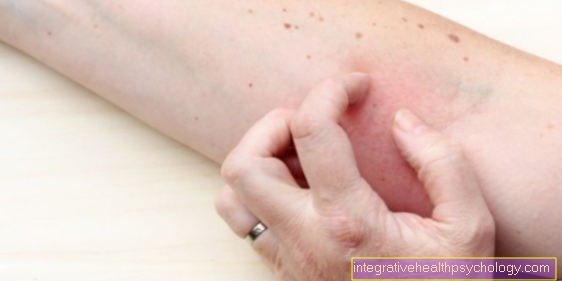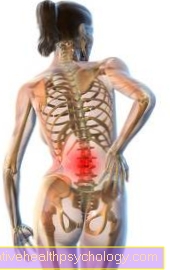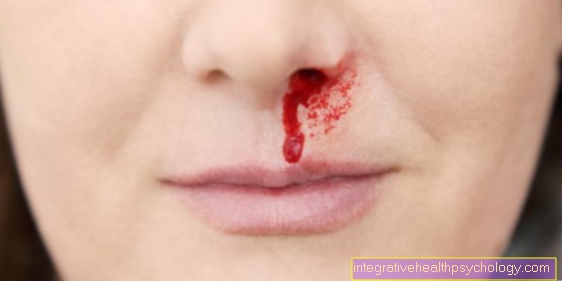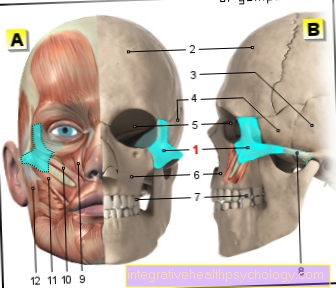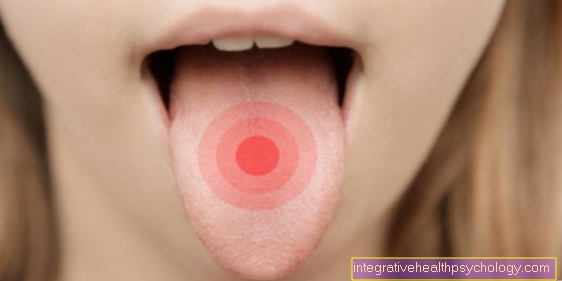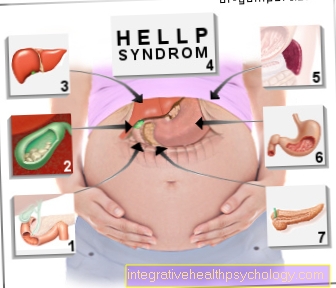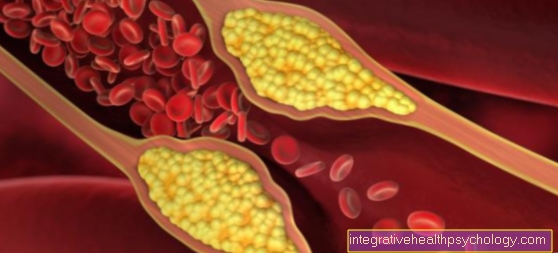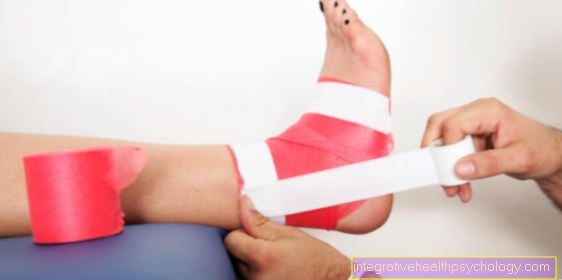Radioiodine therapy
definition
In radioiodine therapy (abbreviated RIT) or radioiodine therapy (RJT) is a Special form of radiationwhich is used exclusively for various benign and malignant diseases of the thyroid gland.

A special type of iodine, which emits radioactive radiation, is usually administered to the patient in tablet form. The body treats it like normal iodine and takes it up almost exclusively in the thyroid gland. The radiation targeted destroys the thyroid tissue, while other organs and tissues are spared.
The therapy must take place on a special nuclear medicine station and is associated with a hospital stay of at least 2 days.
Indications for radioiodine therapy
Radioiodine therapy is a special form of treatment that is used exclusively for diseases of the thyroid gland.
The indications range from benign diseases to certain forms of thyroid cancer. The method of choice is radioiodine therapy for so-called thyroid autonomy.
In this disease, there is thyroid tissue that has eluded the body's control mechanisms and produces thyroid hormones unchecked. The diseased tissue can be specifically destroyed by radioiodine therapy.
The autoimmune disease Graves' disease also increases the production of thyroid hormones. Radioiodine therapy can also be used for this condition.
In most cases, the goal must be to destroy the entire thyroid tissue in order to achieve healing. Radioiodine therapy is also used in various forms of thyroid cancer.
However, this therapy is only possible if the cancer cells, like healthy thyroid cells, also absorb iodine and have not lost this property through degeneration. The alternative to radioiodine therapy is often surgery. In some cases, such as thyroid cancer, both procedures are often combined.
After the thyroid has been surgically removed, radioiodine therapy is performed to destroy any remaining thyroid tissue. In many cases and with timely therapy, thyroid cancer can be cured in this way.
Read more on the subject at:
- Therapy for thyroid cancer
- Thyroid Cancer Cure
- Autonomous adenoma of the thyroid gland
Graves disease
Graves' disease is a disease that, among other things, leads to an overactive thyroid.
So-called antibodies are responsible for this (Proteins released by immune cells), which the body produces and which stimulate the thyroid gland to abnormally increase hormone production (Autoimmune disease of the thyroid).
Those who are ill are usually first treated with drugs that inhibit the excessive production of hormones by the thyroid gland (for example carbimazole). Performs a treatment with these so-called Anti-thyroid drugs not for healing purposes, radioiodine therapy is often recommended in addition to surgery.
This specifically destroys the thyroid tissue. As no thyroid hormones or too few thyroid hormones are produced as a rule, they usually have to be replaced by taking tablets for life.
Read more on the subject at:
- Graves disease
- Symptoms of an overactive thyroid
- Therapy of hyperthyroidism
Procedure radioiodine therapy
Often no special preparation is required in advance of radioiodine therapy.
In the case of certain indications, however, a 4 weeks of use from Thyroid hormone preparations respectively.
Through this so-called Suppression Treatment the body is simulated that the hormone production is too high and the control hormone of the thyroid gland (TSH) lowered. This in turn leads to the fact that the iodine uptake of healthy thyroid tissue is reduced. Thyroid cells with a pathologically increased hormone production are no longer under the influence of TSH.
With radio-iodine therapy, only the autonomic thyroid glands, with their uninhibited function, take up the radioactive iodine. With an appropriate dose, healthy cells are largely protected from radiation.
Course of radioiodine therapy
In Germany, radioiodine therapy is only allowed under inpatient conditions. That means that you are admitted to a special nuclear medicine ward in the hospital for a few days. These stations are with special Radiation protection devicessuch as sewage systems or doors reinforced with lead. Otherwise, these are normal patient rooms and not bunkers or lead chambers, as is sometimes claimed.
The actual therapy begins by giving the patient the radioactive iodine as an active ingredient, usually in the form of a tablet to swallow. Then the patient can retreat to his room.
The body absorbs the radioactive iodine through the intestines and then passes into the blood.
It is initially distributed in the body via the circulation. That is saved radioactive iodine almost exclusively from the thyroid.
Excess iodine is excreted by the kidneys in the urine and thus leaves the human organism.
In order not to endanger other people, especially pregnant women and children, from the radiation, the patients are not allowed to leave the ward or receive any visitors until the radiation subsides.
This is measured daily and is often after 2 days, but rarely after a maximum of 12 days, to such an extent that the patient can be discharged.
After therapy, a Blood control of the thyroid levels. After about 6 months a scintigraphy, which is a measurement of thyroid metabolism, is done to assess whether radioiodine therapy has been successful.
Side effects of radioiodine therapy
Radioiodine therapy has few side effects. Since the radiation used comes from radioactive iodine, which is mainly absorbed by the thyroid gland, the rest of the body is spared.
After treatment, about 1 in 20 therapy cycles may be temporarily painful Inflammatory response coming from the thyroid (Radiation thyroiditis). The doctor then prescribes a so-called Ice tie and pain relievers, which help relieve discomfort.
In rare cases, the inflammatory reaction is curbed by brief treatment with cortisone.
Since the radiation in radioiodine therapy is targeted from within, there are no typical side effects of "normal" radiation from the outside, such as hair loss, nausea or diarrhea.
A side effect that has to be accepted in part is that the body does not produce any or too few thyroid hormones due to the destruction of the thyroid tissue.
In such a case, to prevent hypofunction, these must be supported by a lifelong intake of thyroid hormone preparations (for example thyroxine) be replaced.
In Graves' disease or malignant diseases, this is an acceptable consequence of successful radioiodine therapy, since all thyroid tissue must be destroyed in order to achieve healing. With thyroid autonomy, on the other hand, enough healthy thyroid areas can usually be preserved for adequate function.
Weight gain with radioiodine therapy
There is a weight gain no direct consequence radioiodine therapy. Due to the targeted destruction of the thyroid tissue, however, it can lead to a Hypothyroidism come.
In the treatment of Graves' disease and other malignant diseases, this is usually inevitable, although it occurs as a side effect in the case of thyroid autonomy.
In any case, one should Subfunction the thyroid through the Administration of thyroid hormone preparations, like for example Thyroxine in tablet form.
If this is not done, in addition to many other consequences of hypofunction, weight gain can actually occur.
However, since thyroid function is routinely checked frequently after radioiodine therapy, hypothyroidism is usually recognized in good time and weight gain can be achieved through treatment with, for example Thyroxine be counteracted.
If weight gain does occur, it is likely that there are other causes. Mostly it's up to one high calorie diet and one insufficient physical activity.
Side effect on the eye
Side effects on the eyes are due to radioiodine therapy Not to fear. Other organs, such as the eyes, are spared by the effects of radiation that target the thyroid gland. Changes in the eyes or impaired vision must have another cause and should be examined by an ophthalmologist.
Side effect on the hair
Hair loss due to radioiodine therapy is Not expected. Although it is also a form of radiation, it takes place from within and has a targeted effect on the thyroid tissue.
Irradiation from the outside in the head area, such as a brain tumor, can lead to hair loss.
Bone marrow side effect
Although radiation is released during radioiodine therapy, side effects are on the bone marrow Not to fear.
This is because the radioactive iodine has a targeted effect on the thyroid tissue. The side effects feared with other forms of radiation are not to be feared with radioiodine therapy.
However, drugs that are often used to reduce thyroid function even before radioiodine therapy can, in rare cases, lead to changes in the blood count (for example by carbimazole).
However, this is not a side effect on the bone marrow, but a kind allergic reaction, in which immune cells in the blood are destroyed.
In the long run, any radioactive radiation the body is exposed to increases that Risk of malignant diseases of the bone marrow (Blood cancer or leukemia).
In addition to the natural radiation in our environment and X-ray examinations, this also includes radioiodine therapy. However, it is not a direct cause of such a serious illness.
Side effect taste
Even if the radioactive iodine administered in radioiodine therapy is almost exclusively absorbed by the thyroid gland, a small proportion also gets into the thyroid Salivary glands.
This will less saliva educated. However, since this is important, among other things, to dissolve flavors, some people complain a few days after the therapy of a disturbed taste sensation.
This side effect usually goes away on its own and the taste gradually comes back.
You can prevent the disturbed sensation by chewing gum and sucking sour candy to stimulate the flow of saliva. It is also important to drink enough.
Side effect on the skin
Side effects on the skin are associated with radioiodine therapy Not expected. While with other forms of radiation the radioactivity acts on the outside of the body and thereby usually also affects the skin, this danger does not exist with radiation from the inside through the radioactive iodine.
Only the mucous membrane of the stomach can cause a brief irritation from the capsule with the radioactive iodine, which is noticeable through nausea and a feeling of fullness.
Benefits of radioiodine therapy
The main advantage of radioiodine therapy compared to surgery is that only thyroid tissue is specifically destroyed, while other organs and tissues are spared.
There is no need to make an incision, no anesthesia is required and no scar is left. Radioiodine therapy has few side effects and the risks associated with surgery are avoided.
In addition to the general anesthetic and surgical risks specifically one possible Voice impairmentwhen the nerve supplying the larynx is injured. This runs in close proximity to the thyroid gland.
The risk of a Wound healing disorder is bypassed.
In addition, during an operation there is always the risk that the calcium metabolism required Parathyroid glands also removed become. Radioiodine therapy, however, does not affect the function of the parathyroid glands.
During the operation it can happen that the thyroid tissue cannot be completely removed or remains are overlooked. Radioiodine therapy can make one more effective complete removal can be achieved, provided that a sufficient radiation dose is chosen.
Even if already with a malignant thyroid disease Metastases have spread to other organs, radioiodine therapy can in some cases contribute to their reduction in size or in the best case even destroy them and thus achieve a cure.
Disadvantages of radioiodine therapy
The main disadvantage of radioiodine therapy compared to surgery is that it must not be used in pregnant and breastfeeding women.
In addition, the radioiodine therapy must take place on a special nuclear medicine station, which should not be left until the radiation subsides. The patient is also not allowed to receive visits from relatives during this time, which is why some patients find the stay very boring and lonely.
Furthermore, the radioiodine therapy can be unsuccessful if the administered radiation was not sufficient and must then be repeated if necessary. The more radioactive radiation a person is exposed to, the higher the risk of developing a malignant disease at some point. Therefore, this risk is slightly increased by radioiodine therapy in contrast to surgery.
Duration of treatment of radioiodine therapy
How long radioiodine therapy will last can vary greatly from person to person and cannot necessarily be predicted in advance.
It depends on the size of the irradiated Thyroid volume and the administered radioactivity. Discharge from the ward may only take place if the radiation emanating from the patient causes a Below limit value and no longer poses any danger to those around him.
The radiation is therefore regularly checked by measurements at the same distance. Some patients can be discharged home after two days.
Average stay is around five days. In exceptional cases, however, the radiation can only decrease very slowly, so that the patient is only allowed to leave the ward after up to twelve days.
Inability to work after radioiodine therapy
As a rule, after discharge from the nuclear medicine station after radioiodine therapy, there is no longer any incapacity for work.
In certain exceptional cases, however, it should be used for security certain precautions to be hit. Above all, this includes avoiding close contact with other people in the first few days and keeping your distance as far as possible.
When working with children (e.g. kindergarten teachers or teachers) or when there is longer contact (more than two hours) with the same people at work, the attending physician may certify that the illness has been longer.



